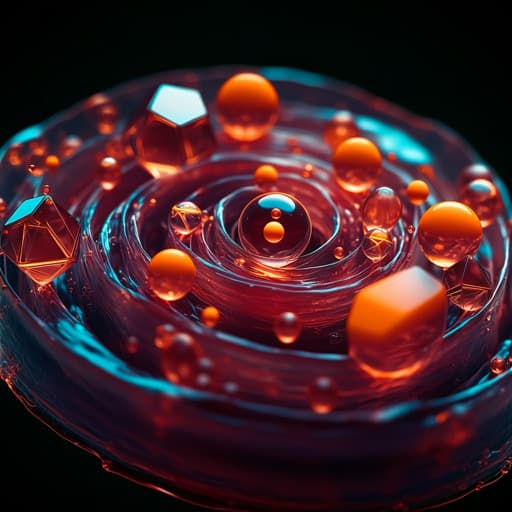
Engineering and Technology
Potential of Coccolithophore Microalgae as Fillers in Starch-Based Films for Active and Sustainable Food Packaging
A. S. P. Moreira, J. Gonçalves, et al.
Discover how employing coccolithophore microalgae like Emiliania huxleyi and Chrysotila pseudoroscoffensis in starch-based films has revolutionized biodegradable and bioactive food packaging. This innovative research conducted by Ana S P Moreira and colleagues highlights enhanced hydrophobicity and impressive antioxidant activity, paving the way for sustainable packaging solutions.
~3 min • Beginner • English
Introduction
Fossil-based plastics dominate food packaging but raise environmental concerns due to their non-renewable origin and poor biodegradability. Driven by circular economy policies, bioplastics and, specifically, biodegradable films from natural polysaccharides (e.g., starch) are being developed as alternatives. However, starch films generally have inferior mechanical and barrier properties compared to synthetic polymers. Reinforcement with fillers (organic or inorganic such as CaCO3) can enhance performance, and incorporating bioactive compounds can add functional properties like antioxidant activity to extend food shelf-life. Microalgae provide polysaccharides, proteins, lipids, and pigments with bioactivity, and prior studies using various microalgae in starch matrices reported decreased tensile strength, varied barrier effects, and improved antioxidant activity. Coccolithophores are distinctive microalgae bearing CaCO3 coccoliths and bioactive lipids/pigments, offering a dual role as inorganic filler and source of bioactives. Despite their unique coccolith structure and ecological role, their use as raw material in materials science has been scarcely explored. This study tests the hypothesis that coccolithophore biomasses (Emiliania huxleyi and Chrysotila pseudoroscoffensis) can serve as fillers in starch-based films to yield biodegradable, bioactive packaging with improved surface hydrophobicity and antioxidant capacity, benchmarking against commercial CaCO3.
Literature Review
- Reinforcing starch films with CaCO3 nanoparticles (0.02–0.5%) can increase tensile strength, elongation at break, and Young’s modulus while decreasing water vapor permeability; however, at higher nanoparticle loadings in other polymer systems, agglomeration can reduce mechanical performance.
- Incorporation of microalgae biomass into starch films (e.g., Nannochloropsis gaditana; Heterochlorella luteoviridis; Dunaliella tertiolecta; Tetradesmus obliquus) typically decreases tensile strength, can modify elongation at break and WVP, and can improve antioxidant activity due to pigments and other bioactives; films containing microalgae extracts have shown inhibition of lipid oxidation in salmon packaging tests.
- Coccolithophores possess high-surface-area biogenic calcite (coccoliths) and species-specific morphologies, along with bioactive lipids and pigments. Prior works focused on oceanic roles and biomineralization rather than material applications; lipidomic analyses report substantial lipids in E. huxleyi and different compositions in C. pseudoroscoffensis, suggesting species-dependent material effects.
These findings motivate testing coccolithophore biomass as multifunctional fillers conferring both structural and active properties to starch films.
Methodology
Materials: Potato starch (Sigma-Aldrich), glycerol (Fisher, 98%), commercial CaCO3 (Merck), ABTS (Fluka), sodium azide (Panreac), anhydrous CaCl2 (Sigma-Aldrich). All reagents were analytical grade.
Microalgae strains and culture: Emiliania huxleyi (AC453; RCC1250) and Chrysotila pseudoroscoffensis (ES-PL0118-01) were grown per previously established conditions. E. huxleyi: starter inoculum in modified K/2 medium in a climatic chamber (20°C; 12:12 h L:D; 50 μmol m−2 s−1), scaled to 500 mL and 5 L flasks with ALGAL medium (final nitrate 0.4 mM) and NaHCO3 (0.087 g L−1), grown at 22 ± 2°C under natural light without aeration (~15 days), manually agitated twice daily. C. pseudoroscoffensis: starter in modified ALGAL medium (nitrate 4 mM) at 22 ± 3°C, PPFD 50 μmol m−2 s−1; scaled to 1 L inocula and then to 5 L under continuous light (24:0), PPFD 100 μmol m−2 s−1 with gentle aeration introduced gradually. Cultures were monitored by OD750 and microscopy; biomass was harvested in late exponential phase by centrifugation (1735× g, 15–20 min) and freeze-dried.
Elemental analysis: 2 mg biomass (triplicate) analyzed for CHNS using a Leco Truspec-Micro CHNS 630-200-200 (combustion furnace 1075°C; afterburner 850°C); nitrogen detected by thermal conductivity; protein estimated using N-to-protein conversion factor 4.78.
Film preparation (solvent casting): Freeze-dried biomass was sieved (75 μm). For each film, sieved biomass was suspended in 50 mL distilled water (1.5% w/v relative to starch dry weight) and stirred 1 h. Potato starch (750 mg) was added, stirred 15 min, then glycerol (225 mg; 30% w/w of starch) added. Gelatinization at 95°C for 30 min under stirring; degassed under vacuum. Cast 21 g of solution onto plexiglass plates (area 144 cm2; 3 mm deep). Dried at 25°C with air circulation for 16 h. Films prepared with fillers at 2.5, 5, 10, and 20% (w/w relative to starch): microalgae biomass (EHUX or CP) or commercial CaCO3. Control films contained starch and glycerol without filler. Films were conditioned ≥5 days at room temperature, ~53% RH before testing.
Characterization:
- Optical properties: CIELab L*, a*, b* measured with a Minolta colorimeter on films over white background; five points per film. Total color variation ΔE versus control computed as ΔE = [(ΔL*)2 + (Δa*)2 + (Δb*)2]1/2.
- Thermal properties: Thermogravimetric analysis (TGA) with STA300 (Hitachi) under air, 5–10 mg sample, 10°C min−1 to 600°C; evaluated control and 20% filler films.
- Mechanical properties: Specimens 9 cm × 1 cm; thickness measured at ≥5 points with digital micrometer. Tensile testing per ASTM D882-2018 on TA.HDi texture analyzer with fixed grips; gauge length 5 cm; crosshead speed 0.5 mm s−1. Young’s modulus, tensile strength, and elongation at break from stress–strain curves; ≥5 strips per condition.
- Wettability: Static water contact angle (WCA) on Top (air-exposed) and Down (plate-contact) surfaces using OCA 20 (Dataphysics) at room temperature; 3 μL ultrapure water droplets; Laplace–Young fitting. Three strips per condition; ≥10 measurements per surface per strip.
- Moisture content: Film squares (4 cm2) dried at 105°C for 16 h; cooled 30 min in desiccator; percentage moisture calculated.
- Solubility in water: Film squares (4 cm2) immersed in 30 mL distilled water with sodium azide (0.02% w/v), 8 days at room temperature, orbital shaking 80 rpm. Residues dried at 105°C for 16 h; weight loss percentage determined (≥3 replicates).
- Water vapor permeability (WVP): ASTM-based method using plexiglass permeation cells containing pre-dried CaCl2; circular film specimens (2 cm diameter) sealed; placed at 53% RH chamber; WVP calculated after 48 h.
- Morphology: SEM (Hitachi SU-70) at 4 kV for films and microalgae; 15 kV for commercial CaCO3. Fresh cultures filtered on 0.4 μm polycarbonate membranes and rinsed; samples mounted on carbon tape and carbon coated. Both Top and Down film surfaces analyzed for control and 2.5%/20% filler films.
- Antioxidant activity: ABTS•+ assay. ABTS 7 mM with 2.45 mM potassium persulfate incubated 16 h in dark to generate ABTS•+; diluted to A734 ≈ 0.8. Film squares (1 cm2) immersed in 3 mL working solution; absorbance measured after 30 min, hourly up to 8 h, and daily up to 6 days (microplate spectrophotometer). Triplicates plus blanks. Inhibition (%) = [(Ablank − Afilm)/Ablank] × 100; statistics by F-test then Student’s t-test at 95% confidence using Python.
All tests performed on films conditioned at ~53% RH; data reported as mean ± SD with significance where applicable.
Key Findings
- Visual/optical: Microalgae-loaded films (especially CP at 10–20%) exhibited green-yellowish hue; CaCO3 at 10–20% yielded whitish films. All remained transparent. CIELab changes with microalgae loading: L* decreased from 90.52 ± 0.34 (control) to 84.19 ± 0.25 (EHUX 20%) and 77.54 ± 0.39 (CP 20%); a* from 2.05 ± 0.03 to −0.98 ± 0.23 (EHUX 20%) and −0.05 ± 0.03 (CP 20%); b* increased from −3.49 ± 0.05 to 11.44 ± 0.26 (EHUX 20%) and 12.40 ± 0.17 (CP 20%). ΔE reached 16.50 ± 0.33 (EHUX 20%) and 20.62 ± 0.37 (CP 20%).
- Morphology (SEM): Fillers (CaCO3 or microalgae coccoliths/coccospheres) were embedded and reasonably dispersed in starch; intact coccoliths visible on both Top and Down surfaces. Some agglomeration observed at 20% microalgae.
- Thickness: Control 28.8 ± 3.4 μm. With fillers: 27.2 ± 1.6 μm (EHUX 2.5%) to 44.7 ± 2.9 μm (CP 20%). CP increased thickness significantly at all loadings; CaCO3 and EHUX increased thickness notably at 10% and 20%.
- Mechanical properties: Young’s modulus decreased from 1361.6 ± 122.8 MPa (control) to 424.4 ± 117.6 MPa (CaCO3 20%), 290.2 ± 62.8 MPa (EHUX 20%), and 333.4 ± 156.8 MPa (CP 20%)—up to 4.7-fold reduction. Tensile strength decreased from 28.4 ± 3.9 MPa (control) to 6.7 ± 2.1 MPa (CaCO3 20%), 2.9 ± 0.9 MPa (EHUX 20%), 4.3 ± 2.5 MPa (CP 20%). Elongation at break decreased from 2.8 ± 0.5% (control) to 2.0 ± 0.3% (CP 10%), 1.9 ± 0.3% (CP 20%), 1.4 ± 0.2% (EHUX 20%).
- Wettability: Control WCA Top 55.5° ± 4.4°, Down 50.7° ± 5.7° (hydrophilic). CaCO3 increased WCA more on Top than Down; highest at 2.5%: Top 94.8° ± 12.5°, Down 72.0° ± 6.5°. Microalgae (2.5–10%) increased WCA on both surfaces to hydrophobic levels: range 103.8° ± 7.1° (CP 10% Down) to 121.3° ± 6.6° (CP 5% Top). At 20% microalgae, Top surfaces remained hydrophobic (EHUX 112.9° ± 6.7°; CP 107.3° ± 9.4°), while Down surfaces showed no significant change (EHUX) or decreased WCA (CP) vs control.
- Solubility in water (8 days): Control weight loss 22.9 ± 5.2%. EHUX 10% decreased loss to 12.6 ± 7.0%; CP 20% increased loss to 34.2 ± 2.3%; other 10–20% conditions generally similar to control.
- Water vapor permeability (WVP): Control 83.2 ± 8.7 pg Pa−1 s−1 m−1. Significant decrease with CaCO3 2.5% (57.7 ± 4.5) and EHUX 5% (51.5 ± 8.1). CP 10% increased WVP to 107.8 ± 4.4. Other conditions not significantly different from control.
- Thermal stability (TGA): Two main weight-loss stages. Second-stage Tmax: control 295.8°C; decreased with microalgae to 278.8°C (CP 20%) and 251.4°C (EHUX 20%); increased with CaCO3 20% to 302.7°C. Residual ash: control 8.0%; CaCO3 20% 19.7%; EHUX 20% 18.6%; CP 20% 12.5%.
- Antioxidant activity (ABTS•+ inhibition, 5 h): Control 0.9% ± 0.2%. CaCO3: 2.5% 6.0% ± 2.1%; 5% 11.6% ± 3.4%; 10% 6.9% ± 2.0%; 20% 13.0% ± 2.2%. Microalgae markedly increased inhibition: EHUX range 11.1% ± 1.1% up to 60.4% ± 5.6% (20%); CP range 10.7% ± 2.4% up to 44.8% ± 4.8% (20%).
Discussion
Incorporating coccolithophore biomasses into starch films addressed the study goal of creating biodegradable, active packaging materials by conferring two key functionalities: increased surface hydrophobicity and enhanced antioxidant capacity. Hydrophobicity (WCA > 90°) observed particularly on Top surfaces for 2.5–10% loadings (and maintained at 20% Top) is consistent with the enrichment of hydrophobic microalgal constituents (lipids, pigments) at the air-exposed surface during solvent evaporation. This can mitigate moisture uptake in hydrophilic starch films, potentially benefiting barrier properties in certain packaging contexts. Antioxidant activity was substantially improved with microalgae versus commercial CaCO3, reaching up to ~60% ABTS•+ inhibition (EHUX 20%), likely due to polar lipids and pigments previously identified in these species. Such activity can retard oxidative spoilage and extend shelf-life of foods.
Trade-offs were observed. The addition of all fillers, including CaCO3, reduced stiffness (Young’s modulus) and tensile strength, with the greatest reductions for microalgae at 20%, likely due to interference with starch chain interactions and possible particle agglomeration at high loadings. Thermal stability slightly decreased with microalgae (organic components lowering decomposition temperatures) but increased with CaCO3; nonetheless, the decomposition onset (>225°C) remains compatible with typical packaging processing. WVP generally remained similar to control, except for modest improvements (CaCO3 2.5%; EHUX 5%) and a deterioration with CP 10%. Solubility outcomes varied by species and loading, reflecting compositional differences (e.g., EHUX higher lipid content).
Compared with commercial CaCO3, coccolithophores provided functional advantages (hydrophobicity, antioxidant activity) while delivering comparable or slightly greater mechanical detriments at higher loadings. Morphological differences (e.g., larger CP coccospheres) influenced thickness and possibly barrier results. Overall, coccolithophore biomass is a promising multifunctional filler for active, sustainable food packaging, with optimization of species, loading, and processing needed to balance mechanical integrity with functional performance.
Conclusion
Coccolithophore biomasses (Emiliania huxleyi and Chrysotila pseudoroscoffensis) can be effectively incorporated into starch-based films by solvent casting, producing transparent, green-yellowish films with hydrophobic surfaces and significant antioxidant activity—properties not achieved with commercial CaCO3 under the same conditions. While mechanical rigidity and strength decrease with filler addition (most pronounced at 20% microalgae), thermal stability remains acceptable for packaging applications. These results demonstrate the potential of coccolithophores as multifunctional fillers enabling active, biodegradable packaging. Future work should optimize formulations (species, particle dispersion, loading), explore extrusion-based thermoplastic starch processing for industrial scalability, and evaluate performance in real food-packaging scenarios (e.g., oxidative stability, moisture/builder barriers, and shelf-life studies).
Limitations
- Mechanical properties (Young’s modulus, tensile strength, and elongation at break) deteriorated with filler incorporation, especially at 20% microalgae, which may limit some packaging applications unless compensated by formulation or process optimization.
- Evidence of filler agglomeration at high loadings (20%) could contribute to mechanical weakening and property heterogeneity.
- Thermal stability decreased with microalgae relative to control (lower Tmax in TGA second stage), though still within usable processing ranges.
- Hydrophobicity improvement was surface-dependent; at 20% microalgae the Down surface did not show the same hydrophobic increase and in CP even decreased, indicating surface heterogeneity due to phase separation during drying.
- WVP effects were modest and condition-dependent; no consistent barrier enhancement across loadings/species.
- No in-pack food trials were conducted in this study to validate functional benefits (e.g., oxidation inhibition, moisture control) under practical storage conditions.
Related Publications
Explore these studies to deepen your understanding of the subject.







